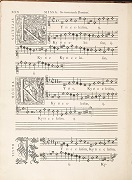Woodblocks and Music from the Museum Plantin-Moretus
Thursday, September 2, 2021

One unexpected benefit of the now-normal online environment is that conferences and workshops, which would have formerly taken place on site with a few dozen participants, are now online and attract hundreds of people from around the globe. Even better, they are often recorded and made available online. One example is the Woodblock Webinar from the Museum Plantin-Moretus which was held online in December 2020 but which we are just catching up with now.
The webinar focused on a project that recently cataloged and digitized over 14,000 woodblocks used by Antwerp’s esteemed Plantin Press. How do you digitize a woodblock? Being 3-D objects, the woodblocks aren’t things that you can just slap on a scanner. The process is complicated by the ways light and shadow play off the wooden objects, so the camera, lens angle, lighting, and object supports all had to be carefully calibrated.
The result of this hard work is the Impressed by Plantin Woodcut Collection Online, which you can browse and search. You can even search by the term “musical instrument” to find woodcuts that depict instruments in initials, vignettes, illustrations, ornamental frames, and more.
Imagine our delight when a music book was used during the webinar to illustrate the woodblock collection. The museum’s researchers determined that 111 woodblocks total were used in George de la Hèle’s Octo missae of 1578 (RISM ID no. 990036116), below, probably the largest book printed by the press at 54.5 x 41.2 cm.
Seven woodcuts can be seen in the opening that begins the Missa In convertendo Dominus (p. 30), five initial Ks and two manicules that guide the bass. The K used as the initial in the Superius part has been cataloged here in the woodcut database. Some of its uses throughout the Octo missae are documented, as are appearances in a further music book: Philippe de Monte’s Missa, ad modulum Benedicta es of 1579 (RISM ID no. 990041912).
The speaker, Joost Depuydt, emphasizes the Herculean efforts it would take to match each woodblock to every book printed over nine generations of the Plantin Press. Therefore, the database won’t tell you every appearance of any given woodcut, nor can you click on a book to find links to all the woodcuts used. But some research has been done by the staff already to get us started and pique our curiosity.
Watch the webinar here:
Image: George de la Hèle, Octo missae quinque, sex et septem vocum. Antwerp: Plantain, 1578, p. 30. RISM ID no. 990036116. Collectie Stad Antwerpen, Museum Plantin-Moretus (public domain).
Share Tweet EmailCatégorie: Evénements

